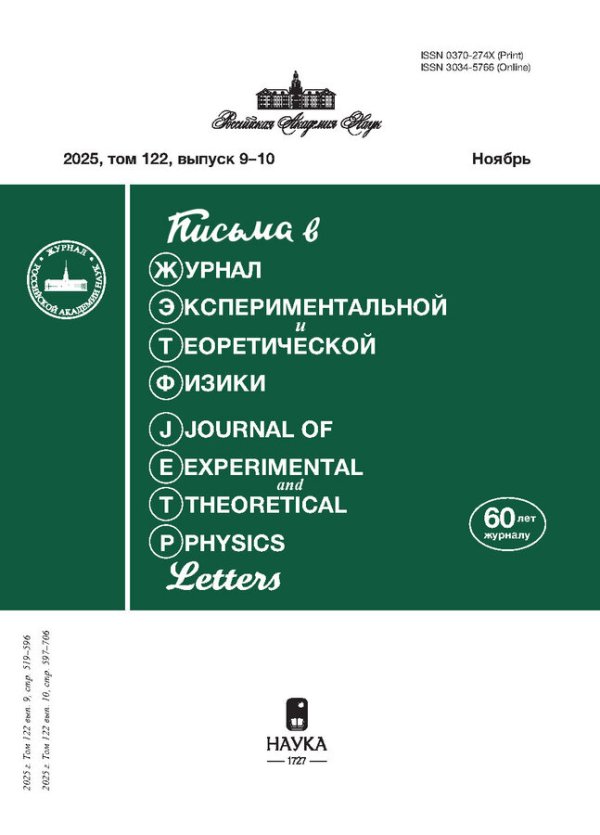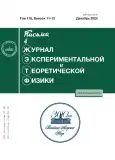Extended Analytical Model for the Description of Light Absorption Spectra of Linear Molecular Aggregates
- Authors: Moritaka S.S.1, Lebedev V.S.1
-
Affiliations:
- Lebedev Physical Institute, Russian Academy of Sciences
- Issue: Vol 118, No 11-12 (12) (2023)
- Pages: 794-801
- Section: Articles
- URL: https://vestnik.nvsu.ru/0370-274X/article/view/664194
- DOI: https://doi.org/10.31857/S1234567823230027
- EDN: https://elibrary.ru/MUGLMC
- ID: 664194
Cite item
Abstract
We study optical properties of linear dye aggregates in which the transition dipole matrix elements of two monomer molecules forming their unit cell are not coplanar with the aggregate axis, and the Frenkel exciton is delocalized along this axis. An analytical model has been developed for the description of polarization effects in the light absorption spectra of such aggregates. It is shown that the nature of their optical spectra differs drastically from previously studied linear aggregates with a single molecule per unit cell. The developed theory contains simple formulas of the well-known Davydov–McRae–Kasha model for conventional linear aggregates as a particular case. A quantitative explanation of the experimental data is given for the absorption spectra of the pseudoisocyanine bromide dye aggregate.
About the authors
S. S. Moritaka
Lebedev Physical Institute, Russian Academy of Sciences
Email: vlebedev@lebedev.ru
119991, Moscow, Russia
V. S. Lebedev
Lebedev Physical Institute, Russian Academy of Sciences
Author for correspondence.
Email: vlebedev@lebedev.ru
119991, Moscow, Russia
References
- F. P. Garc'ia de Arquer, A. Armin, P. Meredith, and E. H. Sargent, Nat. Rev. Mater. 2, 16100 (2017).
- Q. Guo, R. Sekine, L. Ledezma, R. Nehra, D. J. Dean, A. Roy, R. M. Gray, S. Jahani, and A. Marandi, Nature Photon. 16, 625 (2022); https://doi.org/10.1038/s41566-022-01044-5.
- П. Тонкаев, Ю. Кившарь, Письма в ЖЭТФ 112, 658 (2020)
- P. Tonkaev and Y. Kivshar, JETP Lett. 112, 615 (2020); https://doi.org/10.1134/S0021364020220038.
- S. I. Azzam, A. V. Kildishev, R.-M. Ma, C.-Z. Ning, R. Oulton, V. M. Shalaev, M. I. Stockman, J.-L. Xu, and X. Zhang, Light: Sci. Appl. 9, 90 (2020); https://doi.org/10.1038/s41377-020-0319-7.
- А. С. Устинов, А. С. Шорохов, Д. А. Смирнова, Письма в ЖЭТФ 114, 787 (2021)
- A. S. Ustinov, A. S. Shorokhov, and D. A. Smirnova, JETP Lett. 114, 719 (2021); https://doi.org/10.1134/S0021364021240012.
- J. H. Kim, T. Schembri, D. Bialas, M. Stolte, and F. Wu¨rthner, Adv. Mater. 34, 2104678 (2021).
- B. I. Shapiro, A. D. Nekrasov, V. S. Krivobok, and V. S. Lebedev, Opt. Express 26, 30324 (2018).
- А. C. Давыдов, Теория молекулярных экситонов, Наука, М. (1968)
- A. S. Davydov, Theory of Molecular Excitons, Plenum Press, N.Y. (1971).
- E. G. McRae and M. Kasha, J. Chem. Phys. 28, 721 (1958); https://doi.org/10.1063/1.1744225.
- N. J. Hestand and F. C. Spano, Chem. Rev. 118, 7069 (2018); https://doi.org/10.1021/acs.chemrev.7b00581.
- T. Brixner, R. Hildner, J. K¨ohler, C. Lambert, and F. Wu¨rthner, Adv. Energy Mater. 7, 1700236 (2017); https://doi.org/10.1002/aenm.201700236.
- O. Yakar, O. Balci, B. Uzlu, N. Polat, O. Ari, I. Tunc, C. Kocabas, and S. Balci, ACS Appl. Nano Mater. 3, 409 (2020); https://doi.org/10.1021/acsanm.9b02039.
- S. B. Anantharaman, J. Kohlbrecher, G. Rain'o, S. Yakunin, T. St¨oferle, J. Patel, M. Kovalenko, R. F. Mahrt, F. A. Nu¨esch, and J. Heier, Adv. Sci. 8, 1903080 (2021); https://doi.org/10.1002/advs.201903080.
- C. Wang and E. A. Weiss, Nano Lett. 17, 5666 (2017); https://doi.org/10.1021/acs.nanolett.7b02559.
- F. Herrera and M. Litinskaya, J. Chem. Phys. 156, 114702 (2022); https://doi.org/10.1063/5.0080063.
- A. D. Kondorskiy, S. S. Moritaka, and V. S. Lebedev, Opt. Express 30, 4600 (2022); https://doi.org/10.1364/OE.446184.
- A. D. Kondorskiy and V. S. Lebedev, Opt. Express 27, 11783 (2019); https://doi.org/10.1364/OE.27.01178.
- D. Melnikau, P. Samokhvalov, A. S'anchez-Iglesias, M. Grzelczak, I. Nabiev, and Y. P. Rakovich, J. Lumin. 242, 118557 (2022); https://doi.org/10.1016/j.jlumin.2021.118557.
- F. Wu, J. Guo, Y. Huang, Y. Huang, K. Liang, L. Jin, J. Li, X. Deng, R. Jiao, Y. Liu, J. Zhang, W. Zhang, and L. Yu, ACS Nano 15, 2292 (2021); https://doi.org/10.1021/acsnano.0c08274.
- A. D. Bailey, A. P. Deshmukh, N. C. Bradbury, M. Pengshung, T. L. Atallah, J. A. Williams, U. Barotov, D. Neuhauser, E. M. Sletten, and J. R. Caram, Nanoscale 15, 3841 (2023); https://doi.org/10.1039/D2NR05747F.
- D. M. Eisele, C. W. Cone, E. A. Bloemsma, S. M. Vlaming, C. G. F. van der Kwaak, R. J. Silbey, M. G. Bawendi, J. Knoester, J. P. Rabe, and D. A. Vanden Bout, Nat. Chem. 4, 655 (2012); https://doi.org/10.1038/nchem.1380.
- M.-J. Sun, Y. Liu, W. Zeng, Y. S. Zhao, Y.-W. Zhong, and J. Yao, J. Am. Chem. Soc. 141, 6157 (2019); https://doi.org/10.1021/jacs.9b0205.
- A. Weissman, H. Klimovsky, D. Harel, R. Ron, M. Oheim, and A. Salomon, Langmuir 36, 844 (2020); https://doi.org/10.1021/acs.langmuir.9b0275.
- R. M. Hochstrasser and J. D. Whiteman, J. Chem. Phys. 56, 5945 (1972); https://doi.org/10.1063/1.1677140.
- J. Knoester, Int. J. Photoenergy 2006, 061364 (2006); https://doi.org/10.1155/IJP/2006/61364.
- K. Misawa, H. Ono, K. Minoshima, and T. Kobayashi, Appl. Phys. Lett. 63, 577 (1993); https://doi.org/10.1063/1.109954.
- T. Tani, M. Oda, T. Hayashi, H. Ohno, and K. Hirata, J. Lumin. 122-123, 244 (2007); https://doi.org/10.1016/j.jlumin.2006.01.123.
- H. Fidder, Chem. Phys. 341, 158 (2007); https://doi.org/10.1016/j.chemphys.2007.06.016.
- C. Guo, M. Aydin, H.-R. Zhu, and D. L. Akins, J. Phys. Chem. B 106, 5447 (2002); https://doi.org/10.1021/jp025567b.
Supplementary files








